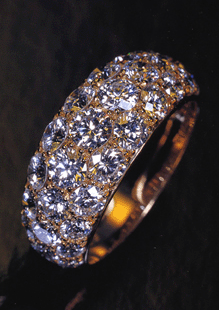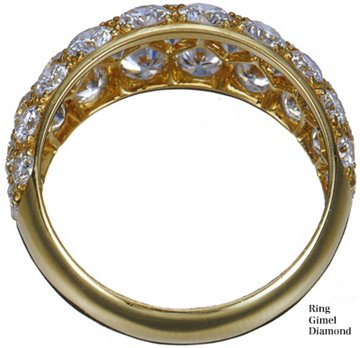This ring uses as many gemstones as possible,filling a limited space with an abundance of brilliance.
This is a domed pavé-set diamond ring that takes the phrase, “Maximum Gem/ Minimum Metal” to the limit. The French word “pavé” means “to cover completely,” and in jewelry it refers to a setting method in which gemstones are set closely together over a surface so that they completely hide the metal base. Because it uses less precious metal, this method characteristically results in jewelry that is very lightweight. With 4.3 grams of precious metal and approximately 0.6 grams (3 carats) of diamonds, this ring’s total weight of only 4.9 grams (0.17 ounce) impresses one with its lightness from the moment it is first held.
The same domed shape was already in use during the ancient Greek and Roman periods. The museum shop at the Louvre Museum in Paris carries reproductions of rings from those periods, and the beauty of their form is spectacular. Not only is this style refined and elegant, it is also very easy to wear. Many forms of rings have been produced and worn since ancient times, and it appears that every imaginable form has already been used. The creation of jewelry of this level is possible thanks to the availability of the special metals required to realize the detailed planning and design behind it.
Again, the quality of jewelry can be judged by looking at the back of a piece. Here the intentions of the producer become apparent. As shown in the photograph below, the metal on the back of this ring has been carefully worked into a deep honeycomb pattern. The purpose of this patterned metalwork, known as “ajour,” is to bring out the beauty of gemstones by allowing light to enter through their pavilions, as well as to permit fluids to drain from the back of the stones during cleaning and wear. Time spent working on such hidden parts of jewelry adds to its cost. However, when considering that jewelry is meant to be worn, and enjoyed for its beauty and the comfort that it brings, such effort is well worth the extra cost.

Gimel
Metal : 18K Yellow Gold
Total weight : 4.9 grams
Size (mm) : L 20 x W 8.0 x H 21


MINIMUM METAL
From the side of this ring, one can see that the diamond’s table facets are positioned considerably higher than the surface of the metal. As the diamonds are set higher, that much more of the ring’s surface is taken up by the diamonds instead of the metal. This way, more diamond covers the limited space available, enhancing the beauty of the piece. To raise the table surface, diamonds with somewhat higher crowns (like the diamond on the left in the photograph below) are used. Because of the firmly established and somewhat standardized nature of the round brilliant cut, not many diamonds are polished with the higher crown, making it necessary to specifically ask the cutter for diamonds that are cut that way.
Speaking of specialized cutting, diamonds with precise symmetry became popular in Japan during the 1990s, based on the notion that diamonds showing a pattern of heart shapes in the pavilion when viewed from the bottom were superior. In fact, this is something that merely increases costs and is unrelated to the essential beauty of diamonds. Cutting a higher crown in order to be able to create jewelry with character has meaning. However, to increase costs for something that has nothing to do with the essence of diamond jewelry- such as whether or not a heart appears-suggests a misunderstanding of what is really important.
Similar types of jewelry are created repeatedly over time. Since ancient times, similar pieces have been used in similar ways. Being products of nature, rough gemstones never undergo modifications or improvements the way automobiles or computers do, and just as basic human emotions and desires remain unchanged, the essence of the form of jewelry does not vary. However, the technology involved in finding gemstone rough, as well as polishing and manufacturing techniques, steady advances to provide an environment where increasingly beautiful jewelry can be created. This simple pavé-set dome ring, realized through a combination of ancient form and modern improved techniques, provides a hint for those aiming to create the jewelry of the 21st century.


TONE SETTING,
PART THREE
The gemstones in these three rings differ in both arrangement and setting method. Ring A is the same pavé-setting shown on the previous pages. Ring B is a repeating bar setting in three rows, while C uses a combination of bar setting and prong setting. A can be seen, there are many possibilities for setting stones in the same amount of space in jewelry, depending on the shapes and sizes of the gemstones. Furthermore, sapphires could be substituted for the yellow diamonds in Ring C; by changing the precious metal to yellow gold, rubies or emeralds could be used as well. A wide variety of
How well a stone is set depends on three factors: (1) the appropriate construction of the stone seating, as seen in the size and shape of the prongs or the width and height of the bezel; (2) the nature of the gemstones themselves, such as the facet arrangements and depths of the stones; and (3) the actual skill of the stone setter. Regarding the nature of the gemstones, if an attractive pavé-set dome ring style is made larger or smaller using the same number of diamonds, it may not longer exhibit its full beauty. The balance will be thrown off, possibly causing the central diamonds to project too much brilliance, or causing the smaller diamonds’ brilliance to appear weak. Jewelry is created through a process of trial and error, and there is always a justifiable reason for the success or failure of a piece.
combinations are possible. However, 950 platinum is softer and about 1.5 times heavier than 750 gold, and colored stones are often cut deeper than diamonds, making them more difficult to set. These factors must be kept in mind when developing a conception for jewelry. Still, imaginative combinations of stone setting styles, gemstones, and precious metals provide many opportunities for the creation of unique, beautiful jewelry.


